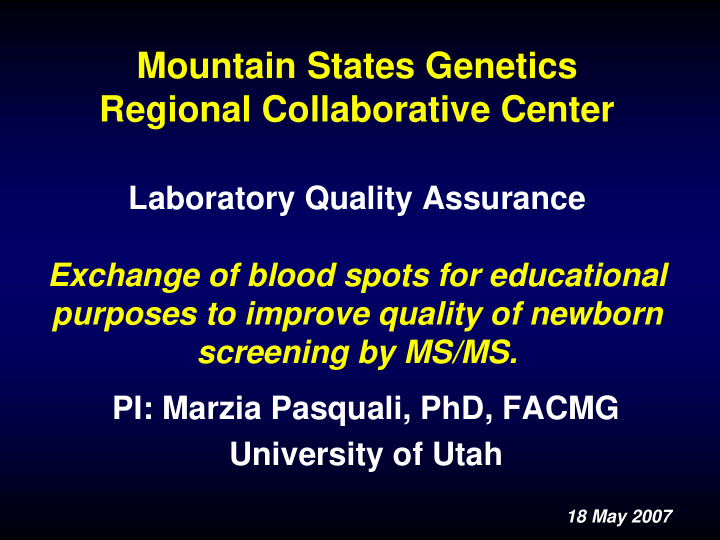



Mountain States Genetics Regional Collaborative Center Laboratory Quality Assurance Exchange of blood spots for educational purposes to improve quality of newborn screening by MS/MS. PI: Marzia Pasquali, PhD, FACMG University of Utah 18 May 2007
Background • Newborn screening by tandem mass spectrometry (MS/MS) has now been implemented in most states. • Challenges with MS/MS cut-offs and interpretation of results have been addressed by the Region 4 Laboratory Quality Improvement activity. • There is still some unresolved issues on how to deal with borderline/abnormal values reflecting iatrogenic effects.
Goal of the project • Improve recognition of abnormal patterns • Decrease the number of unnecessary confirmatory tests • Promote the use of 2 nd tier tests • Decrease the number of false positives (and false negatives in some cases)
Methods • The goal will be achieved by: – Encouraging all the states within Region 6 to participate in Region 4 activity and attend the training sessions – Sending educational challenges (blood spots from real patients with metabolic disorders or with clinical conditions resulting in abnormal amino acids or acylcarnitines) – Compiling a complete report that will address not just the analytical part of testing, but also the follow up/clinical aspect
Existing programs • CDC proficiency testing – Quantitative assessment of several analytes, including amino acids and acylcarnitines • ERNDIM – Qualitative assessment of blood spots, often from adults or patients on therapy
Newborn screening is a program
Diseases to include in the educational challenges • Metabolic disorders detected by MS/MS • Endocrine disorders (CAH) when either the primary screen or a 2 nd tier test is performed by MS/MS • Hyperalimentation, antibiotics, special diets, medications • Other disorders can also be included
Educational challenges • Markers used • 2 nd tier tests used (if applicable) NBS Laboratory • Significance • Recommendations for NBS NBS Laboratory Laboratory follow-up “Review” Panel – Confirmatory tests – Metabolic referral – Urgency NBS NBS Laboratory Laboratory • Involvement of Technical Supervisor/Medical Director/Metabolic consultant
Evaluation Forms • Clinical description of the patient • Abnormal metabolites present in the sample • Explanation of these abnormalities • If applicable, the importance of 2 nd tier tests • Recommendations for follow-up • Lessons learned from different cases
Example Congenital Adrenal Hyperplasia (receiving corticosteroids) • Low Birth Weight (g 2,210) with severe respiratory distress initiated on corticosteroids before collection of newborn screening sample. • MS/MS test results: – 17-hydroxyprogesterone: 7.3 ng/mL (Normal) – androstenedione: 4 ng/mL (Normal) – cortisol: 1.7 ng/mL (LOW) – (17-OHP + androstenedione)/cortisol = 6.7 (Abnormal)
Steroid profile by UPLC-MS/MS Waters Premiere/Acquity 03-May-200719:33:46F1220124200740 Q_Premier VAB574 03-May-2007, 19:33:46 363A207 05_03_07_17 3: MRM of 3 Channels ES+ 2.37 TIC 100 17-hydroxyprogesterone 4.11e4 RT = 2.39 min % 2.09 2.21 2.78 2.54 2.60 2.69 0 1.00 1.10 1.20 1.30 1.40 1.50 1.60 1.70 1.80 1.90 2.00 2.10 2.20 2.30 2.40 2.50 2.60 2.70 2.80 2.90 05_03_07_17 2: MRM of 3 Channels ES+ 2.00 TIC 100 6.55e4 androstenedione RT = 2.00 min % 2.11 0 1.00 1.10 1.20 1.30 1.40 1.50 1.60 1.70 1.80 1.90 2.00 2.10 2.20 2.30 2.40 2.50 2.60 2.70 2.80 2.90 05_03_07_17 1: MRM of 3 Channels ES+ 1.29 TIC 100 2.15e4 cortisol RT = 1.29 min % 1.01 1.10 0 Time 1.00 1.10 1.20 1.30 1.40 1.50 1.60 1.70 1.80 1.90 2.00 2.10 2.20 2.30 2.40 2.50 2.60 2.70 2.80 2.90
Distribution of information • The evaluation forms will be distributed by electronic mail • One meeting/year will be organized to discuss the educational challenges • Results will also be discussed at the regional meetings • Tracking of the performance over time will determine the impact of the training sessions and the educational challenges
Challenges • Obtaining blood from patients – Need for participation of many centers in order to increase the number of cases – Need for participation of NICUs to identify factors affecting NBS results – Need for consent forms that can be shared by other states
Challenges • Consent forms – We will develop general consent forms and we will assist with IRB submission • Tracking of data – Develop a database containing information about participating laboratories – Metrics to objectively evaluate results and compare them over time will be developed
Region 6 New Texas Utah Montana Arizona Colorado Nevada Mexico MS/MS MS/MS Wyoming (No uniform MS/MS MS/MS panel) (ARUP) Wisconsin Oregon MS/MS MS/MS
Enrollment • Although this project will start as a regional effort, enrollment will be open to every laboratory performing NBS by MS/MS • There will be no cost for laboratories to participate
Requirements • Participating laboratories will be asked to: – Analyze 2-3 sets of blood spots twice per year – Fill the results form – E-mail the results – Attend one meeting/year
Summary • This project will: – Improve the quality of screening – Increase awareness and education about metabolic disorders – Complement the activities of Region 4 collaborative project and the existing proficiency testing run by the CDC
Recommend
More recommend